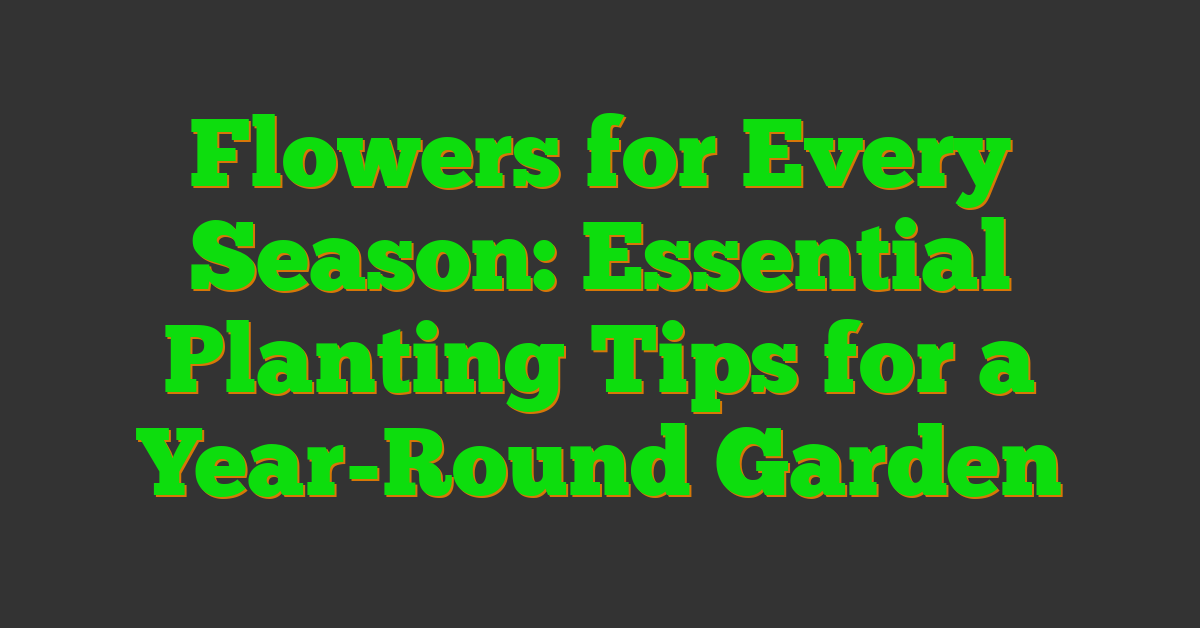Gardening has always been a passion of mine, and there’s nothing quite like seeing vibrant flowers bloom throughout the year. Whether you’re a seasoned gardener or just starting out, choosing the right flowers for each season can transform your garden into a colorful paradise.

In this article, I’ll share my top planting tips to help you select and care for flowers that thrive in spring, summer, fall, and winter. From cheerful tulips in the spring to resilient pansies in the colder months, you’ll discover how to keep your garden blooming no matter the weather.
Spring Flower Planting Tips
Spring’s the perfect time to refresh my garden with vibrant blooms. Here’re my essential tips for planting spring flowers.
Choosing Spring-Ready Species
I select flowers that thrive in spring conditions, like tulips, daffodils, and hyacinths. I ensure species are cold-hardy and bloom during the early growing season. I consider factors such as:
- Sunlight requirements
- Soil type
- Mature plant size
Soil Preparation and Planting Techniques
- Plant bulbs at a depth three times their height
- Space them 4-6 inches apart
- Water thoroughly after planting
- Apply mulch to retain moisture and suppress weeds
Summer Flower Care
I maintain vibrant blooms during summer by selecting the right flowers and adopting effective care strategies. Here’s how I ensure my garden thrives in the heat.
Selecting Heat-Resistant Flowers
I choose flowers that withstand high temperatures and intense sunlight:
- Marigolds: Tolerate heat, require full sun.
- Zinnias: Thrive in warm conditions, come in various colors.
- Petunias: Heat-resistant, bloom continuously with proper care.
- Portulaca: Succulent-like flowers, drought-tolerant.
- Lavender: Prefers full sun, withstands dry conditions.
Watering and Maintenance Strategies
- Watering: I water early in the morning to reduce evaporation, providing 1 inch of water per week.
- Mulching: I apply a 2-inch layer of mulch to retain soil moisture and suppress weeds.
- Deadheading: I regularly remove spent blooms to encourage new growth.
- Fertilizing: I use a balanced fertilizer every four weeks to support continuous flowering.
- Pest Control: I monitor for pests and apply appropriate treatments promptly.
Fall Flower Gardening
As summer fades, I prepare my garden for the vibrant colors of autumn. Planting the right flowers ensures a stunning display as the seasons change.
Planting for Autumn Blooms
I select flowers that thrive in cooler temperatures to ensure continuous blooms. Chrysanthemums, asters, and sedum are top choices for fall gardens. I plant bulbs and seeds by late summer, ensuring they receive at least six hours of sunlight daily. Spacing plants 12-18 inches apart promotes healthy growth and ample airflow. I water thoroughly after planting and apply a 2-inch layer of mulch to retain moisture and regulate soil temperature.
Preparing Your Garden for Fall
Preparing the garden for fall involves several key steps. I start by removing spent summer plants to prevent disease and pests. Next, I enrich the soil with compost, adding 2 inches to improve fertility and structure. Adjusting the soil pH to between 6.0 and 7.0 ensures optimal nutrient uptake for fall blooms. I also prune any overgrown shrubs and trees, shaping them for winter dormancy. Finally, I apply a thick layer of mulch to insulate the soil, suppress weeds, and maintain consistent moisture levels throughout the cooler months.
Winter Flower Strategies
Winter may seem challenging for gardening, but with the right strategies, you can enjoy vibrant blooms even in the cold months. Here are some effective approaches to ensure your garden thrives during winter.
Indoor Flower Options
During winter, I focus on selecting flowers that flourish indoors. I choose varieties like:
- Amaryllis: Bright blooms that add a splash of color.
- Christmas Cactus: Long-lasting flowers in various hues.
- Cyclamen: Delicate flowers with attractive foliage.
- Poinsettias: Classic winter favorites with vibrant bracts.
To maintain these flowers, I ensure they receive adequate light by placing them near windows. I also monitor indoor temperatures, keeping them between 60-70°F, and water them regularly, allowing the soil to dry slightly between waterings.
Protecting Outdoor Plants
Protecting outdoor plants is crucial for their survival in winter. I implement the following techniques:
- Mulching: Applying a 2-3 inch layer of mulch around plants to insulate the soil and retain moisture.
- Covering: Using frost blankets or burlap to shield sensitive plants from harsh winds and freezing temperatures.
- Pruning: Removing dead or damaged branches to reduce the risk of breakage under snow or ice.
- Watering: Providing occasional deep watering during dry spells to prevent root desiccation.
- Choosing Hardy Varieties: Selecting winter-hardy species such as pansies, hellebores, and winter jasmine that can withstand lower temperatures.
By following these strategies, I ensure my outdoor plants remain healthy and ready to bloom once spring arrives.
Conclusion
Gardening through every season brings endless joy and color to my life. By carefully choosing the right flowers and following these simple planting tips you can create a vibrant garden that blooms all year long. Whether I’m welcoming spring tulips or enjoying winter pansies each season offers its own beauty and rewards. Seeing my garden thrive through the months is truly fulfilling. I hope these tips inspire you to cultivate your own colorful oasis. Happy planting and may your garden flourish every season!
















